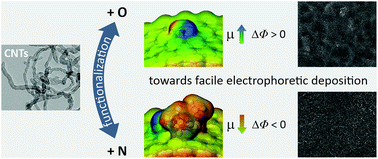Covalently bonded surface functional groups on carbon nanotubes: from molecular modeling to practical applications†
Abstract
The aim of this work was to investigate how chemical functionalization affects the electronic properties of multi-walled carbon nanotubes, altering the electrophoretic deposition process: a method of choice for the fabrication of high quality, all-carbon nanotube (CNT) layers. Wet chemistry methods were applied to modify the surfaces of CNTs by insertion of various oxygen- and nitrogen-containing groups. Transmission electron microscopy revealed no significant changes in the material morphology, while X-ray photoelectron spectroscopy and Raman spectroscopy showed that changes in the chemical composition did not translate to the changes in the structure. Molecularly modelled optimized surface functional group geometries and electron density distributions allowed the calculation of the dipole moments (–COOH = 0.77; –OH = 1.65; –CON(CH3CH2)2 = 3.33; –CONH2 = 2.00; –NH2 = 0.78). Due to their polarity, the introduction of surface functional groups resulted in significant modifications of the electronic properties of CNTs, as elucidated by work function measurements via the Kelvin method and ultraviolet photoelectron spectroscopy. The work function changed from 4.6 eV (raw CNTs) to 4.94 eV for the –OH functionalized CNTs and 4.3 eV for the CNTs functionalized with –CON(CH3CH2), and was inversely proportional to the dipole moment values. Finally, using CNT dispersions, electrophoretic deposition was conducted, allowing the correlation of the work function of CNTs and the measured electrophoretic current with the impact on the deposits' qualities. Thus, a rational background for the development of carbon-based biomaterials was provided.



 Please wait while we load your content...
Please wait while we load your content...